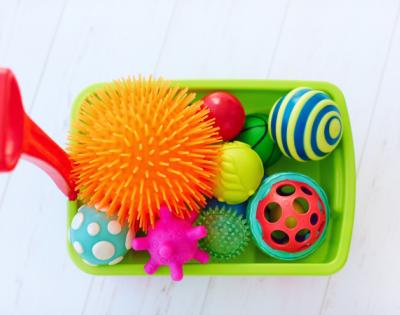
Everyone gets stressed and overwhelmed. One way to regulate big feelings is to use sensory interventions to help calm your body and mind and process your thoughts. If you use sensory approaches to help control your emotions, you can make a sensory bin whenever you feel anxious. Keeping all of your favorite sensory toys in one spot makes it easier to deal with emotions when you're feeling overwhelmed. Here are four steps to get your sensory bin started:
1. Identify your primary sense
Everyone has senses that are more sensitive than others. Think about which of your senses are most perceptive to stimuli. Do you seem to have a stronger nose than other people? Do loud noises bother you? Maybe you see colors more vibrantly, or you're more careful about touching (or not touching) certain textures. No matter which it is, you probably have a sense that feels stronger than others. You might have more than one, which just means more opportunities for sensory intervention.
2. Find sensory tools and toys
After you've determined what your primary sense is, gather up tools and toys that will help stimulate that sense. Not sure where to start? Check out our list of sensory tools and toys organized by category.
If you don't have the budget to buy a bunch of new things, you can find or make your own items for a sensory bin. Bismarck Therapist Taylor Anderson spends time with clients figuring out creative ways to make sensory bin items and stimulate senses, like:
- Cut up pieces of tissue paper or cardstock and spray room freshener on them
- Mix dish soap, water, and glitter or food coloring to make a tornado in a bottle
- Pet or cuddle a stuffed animal you already own and love to stimulate touch
- Use books on your lap instead of a weighted blanket
- Lay on a warm concrete sidewalk in the sun if you like heat
- Swing at a playground for back-and-forth movement
- Burrito yourself in a blanket for a tight wrap if pressure feels nice
- Find some water and make ripples by throwing a rock into it - this can also be a great meditation practice!
- Watch blades of grass sway back and forth
- Chew gum to stimulate your oral sense
You can put some of these things, like toys, books, and blankets, in your sensory bin. For the other things, write yourself a note to stick in your bin so you'll know just what to do when you're feeling overwhelmed and won't have to think about it.
3. Build your sensory bin
Get a cute basket or box that you like and put all your new things in it. Make sure there aren't big holes that the toys can fall out of. You can buy a new basket if you'd like or use something you already have around the house. Decorate a shoebox and take the opportunity to have a fun creative session.
4. Put your bin in a good spot
Find a home for your sensory bin in a place where you hang out often. You can always make more than one sensory bin if you'd like, one in your room, one in the kitchen, and one at the office. Just be sure to place your bin(s) somewhere you can access it when you think you'll need it most.




